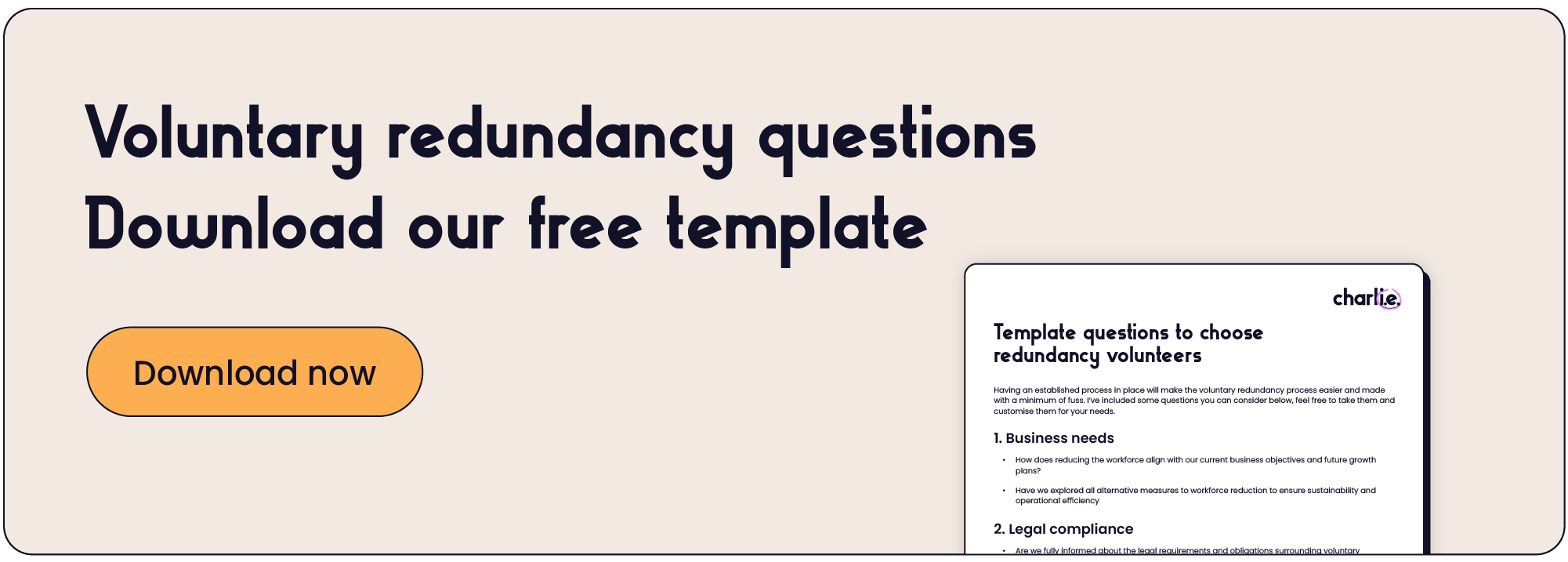Voluntary redundancies and why you have to make them + free template

Voluntary redundancies are a strategic option for small business owners to downsize their workforce because of financial pressures or organisational restructuring, but in a way that doesn’t leave your employees out hanging to dry.
When you give your employees the option to be chosen for redundancy, you take proactive measures to solve financial pressures, and help maintain morale with your existing team when they see you make an effort to be transparent and fair.
In this post, I’ll guide you through the process of making a voluntary redundancy, and offer you a template of questions you can use in your own redundancy process.
What is a voluntary redundancy?
When your business needs to let go of people because of financial constraints or restructuring, voluntary redundancies are an option you can give to your employees where they choose to leave their role in return for financial compensation.
This is in contrast to compulsory redundancies where the employee is let go without giving them an option.
What are the benefits of voluntary redundancies for employers?
As a small business leader, you need to make difficult choices when you let go of people to save on operational costs. Offering voluntary redundancy lets you do that without throwing your hard-working team members under the bus.
Making voluntary redundancies an option lets you:
- adjust the size of your workforce
- eliminate any roles that are outdated or no longer relevant
- keep any upheaval to your business at a minimum
Giving the shift of power in the redundancy process back to your employees makes the process fair and ethical. Your employees will be less resentful and fearful of their jobs when they see you making an effort to be transparent and strategic in how you handle it.
What are the challenges of voluntary redundancies?
Voluntary redundancies can also be challenging for employers:
- Experienced and senior employees who choose voluntary redundancy can leave you with a gap in skills and talent which is hard to fill.
- You have to offer redundancy packages to anyone who takes the out, and that can leave your small business with financial strain.
- Your operations will likely see a shake-up as you adjust to the changes, and bring any new hires up to speed during the handover could be challenging.
How does voluntary redundancy work?
The selection for voluntary redundancies work in the following way:
- Age
- Disability
- Gender reassignment
- Marriage and civil partnership
- Pregnancy and maternity
- Race
- Religion or belief
- Sex
- Sexual orientation
The steps in the process are:
- Communication
First, consider whether making redundancies is the only option and if you can’t make cutbacks elsewhere. Explore alternatives, if there are any.
If you move forward with the process, tell your employees about the potential for redundancies and ask for volunteers and accept offers if any come forward.
- Initial planning
If you’re planning 20 or more redundancies, you must make a collective consultation. During the redundancy consultation, you must give written notice explaining why you need to make the redundancies, which jobs are at risk and how many, and how you plan to carry it out.
If there are fewer than 20 redundancies required, you should consult with each employee individually.
Inform the employees about the redundancy offer,
- Communicating the offer
During the process, let your employees in the consultation know what they can expect in the redundancy offer in terms of eligibility, benefits, and the steps in the process itself.
- Application and selection
Tell your affected employees how to volunteer for redundancy and the criteria you’ll use to review their applications.
At this point, you should clarify that not all applications might be selected, and the decision will be made based on your company’s strategic goals and the skills you need to reach them.
- Finalising the process
Initiate the redundancies, give notice periods, and make any final payments. Offer to give your employees any support they need going forward as they depart from your organisation, like career counselling or assistance with the job search.
Financial considerations for employers
How much redundancy you pay to your employees will depend on their:
- Age
- Length of time they have spent working for you
- Weekly pay before tax
That includes ‘guaranteed overtime’, commission, or any bonuses. Offer more than the statutory amount to incentivise voluntary redundancies. Note that redundancy pay up to £30,000 is tax-free.
If you propose a new role to the employee and they say no, they may lose their statutory redundancy pay.
Understanding both the long and short-term consequences on your business’s financial health will make it clear whether or not to carry out these voluntary redundancies or sort out other solutions.
Template questions to choose redundancy volunteers
Having an established process in place will make the voluntary redundancy process easier and made with a minimum of fuss. I’ve included some questions you can consider below, feel free to take them and customise them for your needs:
1. Business needs
- How does reducing the workforce align with our current business objectives and future growth plans?
- Have we explored all alternative measures to workforce reduction to ensure sustainability and operational efficiency?
2. Legal compliance
- Are we fully informed about the legal requirements and obligations surrounding voluntary redundancy under UK employment law?
- How will we ensure that our voluntary redundancy process complies with equality and anti-discrimination laws?
3. Communication strategy
- What plan do we have in place to communicate the voluntary redundancy scheme clearly and compassionately to our employees?
- How will we manage and respond to employee feedback and concerns throughout the redundancy process?
4. Employee consultation
- Have we established a structured consultation process that allows for meaningful input from employees and, if applicable, their representatives?
- How can we ensure that the consultation process is perceived as genuine and not just a formality?
5. Selection criteria
- What selection criteria will we use to select employees for voluntary redundancy, and how can we ensure these are fair and transparent?
- How will we handle situations where the number of volunteers exceeds or falls short of our workforce reduction target?
6. Financial implications
- Have we conducted a comprehensive analysis of the financial impact of the voluntary redundancy scheme, including potential savings and costs?
- How will the voluntary redundancy payments be structured to maintain financial stability while offering fair compensation to departing employees?
7. Support services
- What support services, such as career counselling or financial planning advice, will we provide to employees taking voluntary redundancy?
- How can we assist employees in transitioning to their next employment or career phase effectively?
8. Reputation management
- How do we plan to manage the potential impact of the voluntary redundancy process on our company’s reputation among stakeholders and the wider community?
- What proactive measures can we take to maintain a positive employer brand during and after the redundancy process?
9. Future workforce planning
- How will the voluntary redundancy scheme affect our workforce planning and the skill sets required for future business success?
- What strategies will we implement to address potential skills gaps and ensure the remaining workforce aligns with our strategic goals?
10. Ethical considerations
- How will we ensure that the voluntary redundancy scheme is implemented ethically, respecting the dignity and rights of all employees?
- What measures are in place to provide equitable treatment for all employees, regardless of their decision regarding voluntary redundancy?



